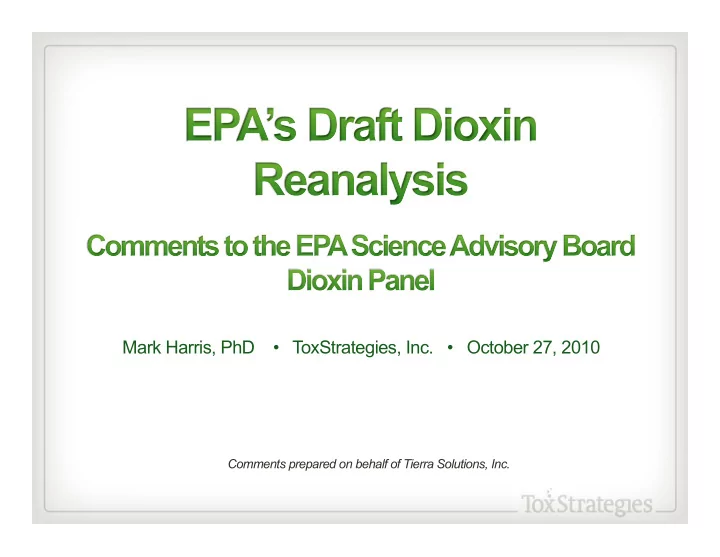

Mark Harris, PhD • ToxStrategies, Inc. • October 27, 2010 Comments prepared on behalf of Tierra Solutions, Inc.
Fingerhut et al. (1991) “…our study did not directly assess the effect of exposure to TCDD alone. The workers were exposed concurrently to the chlorophenols and phenoxy herbicides that were contaminated with TCDD. In addition, they may have been exposed to numerous other chemicals while employed at the plants.” Steenland et al. (2001) “Besides dioxin, only one known occupational carcinogen has been identified in this cohort, present at a single plant and affecting a single, relatively rare cancer (bladder).” EPA Draft Reanalysis (2010) “This study meets the epidemiological considerations noted previously as there is no evidence that the study is subject to bias from confounding due to cigarette smoking or other occupational exposures”
The NIOSH cohort (used for derivation of the OSF) was exposed to known and potential carcinogens*: 2,3,4,6-Tetrachlorophenol Dieldrin Nitrobenzene 2,4-Dichlorophenol † o -Toluene † Dioxane 2,4,5-Trichlorophenol † Ethyl acrylate o -Toluidine 2,4,6-Trichlorophenol Ethylene dichloride p -Aminobiphenyl p -Dichlorobenzene † 2,5-Dichlorophenol Ethylene oxide Hexachlorobenzene † Acetaldehyde Parathion Aldrin Hexachlorobutadiene Pentachlorophenol Methylene chloride † Aniline Petroleum polymer resins Benzene † Monochlorophenol Polychlorinated biphenyls Carbon tetrachloride n -Butyl benzyl phthalate Sulfallate Diamine N -Nitrosodimethylamine Sulfuric acid Dichlorodiphenyltrichloroethane † N -nitrosomorpholine Trichloroethylene *see NIOSH Plant reports (January 1984 – January 1991) † Chemicals identified in soil and/or groundwater at Plant 1 – documentation that these were released into work environment The EPA inconsistently excluded studies using confounding exposures as a rationale (e.g., Michalek and Pavuk 2008 excluded for inability to control for 2,4-D exposures)
NIOSH Cohort exposure estimates (e.g., dose) were based on a job exposure matrix that is subjective and qualitative Actual measurements of TCDD serum concentrations limited to 170 of 3,538 workers Mean TCDD Fraction of Day Daily & Concentrations Contact Worker Exposed Cumulative in Product at Factor to TCDD Exposure Scores Each Plant L IMITATIONS L IMITATIONS L IMITATIONS L IMITATIONS 1. Multiplying qualitative 1. Incomplete TCDD 1. Subjective (qualitative) 1. Assumes equivalent and quantitative values Concentration Data value developed by daily exposure results in a qualitative NIOSH durations among measure 2. Large percent of LODs individuals within a job 2. Assumes job types heavily influenced type exactly the same 2. Reflects compounded mean data between plants uncertainties 3. Not a direct measure 3. No sensitivity analysis of exposure performed
The critical noncancer effect selected by the EPA was based on data that: 1. Were not clinically significant (see figure below) 2. Were not actually reported by the authors of the study 3. Did not demonstrate a dose-response relationship (see figure below) 4. Were not supported by a discussion on biological plausibility 5. Were insufficient to determine if effects were associated with TCDD exposures 6. Did not include other PCDD/Fs or other chemicals that were likely present as a result of the explosion
1. The draft RfD and OSF suggest that the U.S. food supply may be unsafe for human consumption Risk-based concentrations calculated using EPA’s proposed toxicity factors exceed average concentrations reported by EPA scientists for beef, milk, and fish 2. The current intake of TCDD from breast milk far exceeds the RfD Typical background intake from breast milk reported by EPA scientists is 242 pg TEQ/kg-day (Lorber and Phillips, 2002) vs. the RfD of 0.7 pg/kg-day 3. Use of the RfD and OSF indicate that soils in urban areas contain unacceptable levels of PCDD/Fs Use of the draft RfD and OSF will cause significant resources to be allocated to site investigation/remediation with little or no apparent public health benefit
Recommend
More recommend